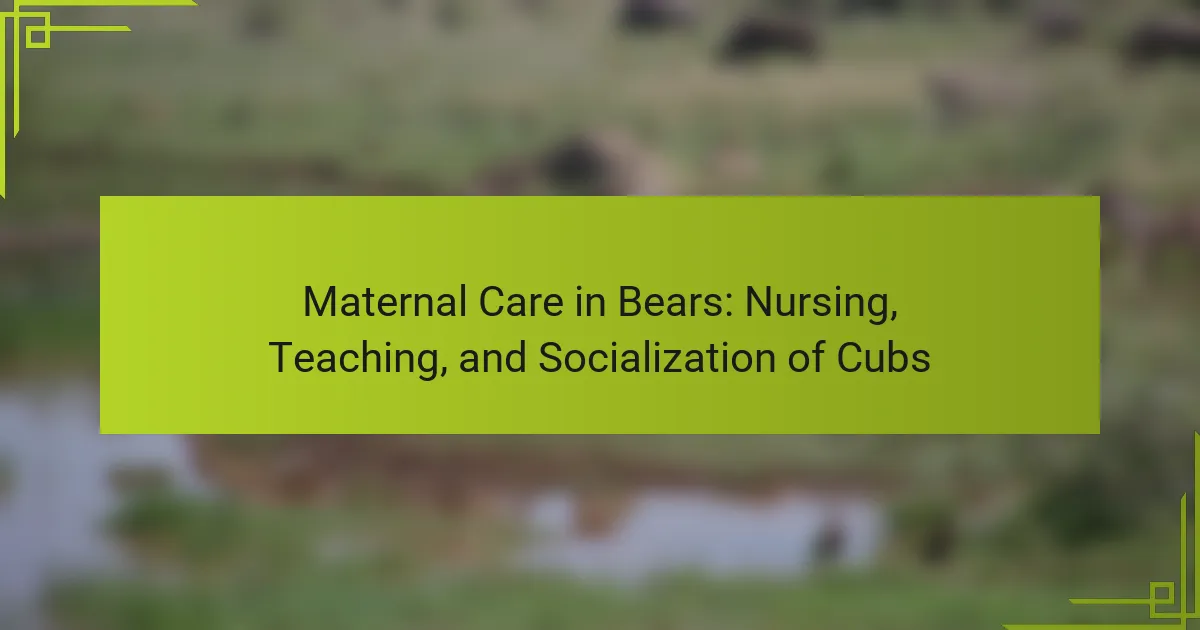Maternal care in bears encompasses the nurturing behaviors exhibited by mother bears towards their cubs, including nursing, protection, and teaching essential survival skills. Mother bears typically give birth to one to four cubs, who are born blind and helpless, relying on their mother for warmth and nutrition. The article highlights the importance of nursing, which provides vital nutrients for growth and supports the cubs’ immune systems, as well as the teaching of foraging skills essential for their future independence. Additionally, it discusses the socialization process through play and maternal discipline, which helps cubs understand social hierarchies and interactions. Research indicates that attentive maternal care significantly enhances cub survival rates in the wild.

What is Maternal Care in Bears?
Maternal care in bears refers to the nurturing behaviors exhibited by mother bears towards their cubs. This care includes nursing, protection, and teaching essential survival skills. Mother bears typically give birth to one to four cubs, depending on the species. Cubs are born blind and helpless, relying entirely on their mother for warmth and food. The mother nurses her cubs for several months, providing them with vital nutrients. During this time, she also teaches them how to forage for food and avoid dangers. Maternal care is crucial for the cubs’ development and survival in the wild. Studies show that cubs raised with attentive maternal care have higher survival rates.
How do bears exhibit maternal care towards their cubs?
Bears exhibit maternal care towards their cubs through nursing, protection, and teaching. Mother bears nurse their cubs for several months, providing essential nutrients for growth. They also create a safe environment by defending their young from predators. Maternal bears teach their cubs essential survival skills, such as foraging for food and recognizing threats. Research shows that bear mothers are highly attentive, often staying close to their cubs during their early development. This close bond is crucial for the cubs’ survival and learning. For example, studies indicate that bear cubs learn vital skills through observation and imitation of their mothers.
What are the stages of maternal care in bears?
The stages of maternal care in bears include denning, nursing, and teaching. During the denning stage, a mother bear prepares a safe space to give birth and raise her cubs. This typically occurs in winter months when food is scarce. After giving birth, the mother enters the nursing stage. She provides milk to her cubs, which is crucial for their growth and development. Nursing can last several months.
As the cubs grow, the mother transitions to the teaching stage. In this phase, she introduces her cubs to foraging and survival skills. This teaching is essential for the cubs’ independence. The mother bear actively engages with her cubs, showing them how to find food and avoid dangers. These stages are critical for the successful rearing of bear cubs, ensuring their survival and adaptation to the wild.
How does maternal care vary among different bear species?
Maternal care varies significantly among different bear species. For example, black bears exhibit a high level of maternal investment. They typically care for their cubs for about 1.5 years. In contrast, polar bears provide maternal care for a shorter duration, usually around 2.5 years. Grizzly bears also show strong maternal behavior, with mothers teaching their cubs essential survival skills.
The amount of care can depend on environmental factors and food availability. Black bears may have more cubs due to abundant food sources. Polar bears, however, often have fewer cubs due to the harsh Arctic environment. Each species adapts its maternal care strategies to optimize cub survival in its specific habitat.
Why is maternal care important for bear cubs?
Maternal care is crucial for bear cubs’ survival and development. This care provides essential nutrition through nursing, which is vital for growth. Bear milk contains high fat and protein levels, promoting healthy weight gain. Maternal care also teaches cubs vital survival skills. Cubs learn foraging, hunting, and social behaviors from their mothers. This learning is critical for their independence. Additionally, maternal protection ensures cubs are safe from predators. Research indicates that cubs with attentive mothers have higher survival rates. Overall, maternal care directly impacts the long-term success of bear cubs in the wild.
What are the survival rates of cubs with maternal care compared to those without?
Cubs with maternal care have significantly higher survival rates than those without. Research indicates that cubs receiving maternal care have survival rates exceeding 80%. In contrast, cubs without maternal care often face survival rates as low as 30%. Maternal care provides essential resources such as nutrition, protection, and social learning. These factors are critical for the development and survival of cubs in their early stages. Studies show that maternal investment directly correlates with cub survival and overall health.
How does maternal care influence the development of bear cubs?
Maternal care significantly influences the development of bear cubs. Maternal care includes nursing, protection, and teaching essential survival skills. Bear mothers provide milk that is rich in nutrients, crucial for cub growth. This milk supports the cubs’ immune systems during their early life. Mothers also protect cubs from predators and environmental dangers. Teaching behaviors such as foraging and social interactions is vital for cub survival. Studies show that cubs raised with attentive mothers have higher survival rates. For example, research indicates that maternal investment directly correlates with cub health and development outcomes.

What roles do nursing and feeding play in maternal care?
Nursing and feeding are crucial components of maternal care in bears. They provide essential nutrients to cubs for growth and development. Mothers nurse their cubs for several months, ensuring a steady supply of milk rich in fats and proteins. This milk supports the cub’s immune system and overall health. Feeding also includes teaching cubs how to forage for food. This skill is vital for their survival once they are weaned. Research shows that cubs learn by observing their mothers during feeding. This process enhances their ability to find food independently later in life. Thus, nursing and feeding are foundational for cub well-being and survival.
How do mother bears nurse their cubs?
Mother bears nurse their cubs by providing them with milk directly from their teats. This process typically begins shortly after the cubs are born. The cubs instinctively crawl to their mother’s belly to find the teats. Nursing occurs frequently, especially in the first few weeks. The milk is rich in nutrients, supporting rapid growth. Mother bears can produce a large quantity of milk to meet the demands of their growing cubs. Nursing continues for several months, often until the cubs are weaned at around six months of age. This close nursing bond is crucial for the cubs’ survival and development.
What is the duration and frequency of nursing in bear cubs?
Bear cubs typically nurse for about six months. During this period, they nurse frequently, often every two to three hours. This frequency supports their rapid growth and development. Nursing provides essential nutrients that cubs need to thrive. In the wild, cubs rely on their mother’s milk until they begin to eat solid food. The transition to solid food usually starts around four months of age. This nursing duration and frequency are vital for their survival and health.
What nutritional benefits do cubs receive from their mother’s milk?
Cubs receive essential nutritional benefits from their mother’s milk. The milk is rich in proteins, fats, and carbohydrates. These nutrients support rapid growth and development. Additionally, mother’s milk contains antibodies that boost the cub’s immune system. This immune support is crucial in the early weeks of life. The milk also provides hydration, which is vital for cubs. Furthermore, it contains vitamins and minerals necessary for overall health. Studies show that cubs thrive on this nutrient-dense milk during their early life stages.
How does the weaning process occur in bear cubs?
The weaning process in bear cubs occurs gradually as they transition from milk to solid food. Initially, cubs rely entirely on their mother’s milk for nutrition. As they grow, typically around three months of age, they begin to sample solid foods. The mother introduces various foods, including berries, plants, and insects. This exposure helps cubs learn to forage and identify edible items. By six months, cubs consume more solid food and less milk. Complete weaning usually occurs by the age of one year. During this time, the mother continues to provide guidance and protection. This gradual process ensures that cubs develop the necessary skills for survival.
What signs indicate that a cub is ready to be weaned?
Cubs show several signs indicating readiness for weaning. Increased interest in solid food is a primary sign. Cubs may begin to consume more of their mother’s food. They may also exhibit less dependence on nursing. Playful behavior with siblings can increase during this time. Additionally, a noticeable decrease in nursing frequency occurs. As cubs grow, they may seek independence more actively. These behaviors typically emerge around four to six months of age. Research supports that these signs correlate with natural weaning processes in bear species.
How does weaning affect the mother-cub relationship?
Weaning alters the mother-cub relationship by shifting dependence from the mother to independent foraging. During weaning, cubs gradually reduce nursing frequency, fostering self-reliance. This transition encourages cubs to explore their environment and learn survival skills. The mother may become less nurturing as cubs start to eat solid food. This change can lead to a decrease in physical closeness and nurturing behaviors. However, the mother continues to provide guidance and protection. Research indicates that the weaning process is crucial for cubs’ development. It prepares them for eventual independence in the wild.

How do mother bears teach and socialize their cubs?
Mother bears teach and socialize their cubs through various behaviors and interactions. They provide guidance on foraging and finding food. Cubs learn by observing their mother’s actions and mimicking them. Play is a crucial part of socialization, allowing cubs to develop important skills. Mother bears also discipline their cubs to establish boundaries. This helps cubs understand social hierarchies and interactions with other bears. Research indicates that these maternal behaviors are essential for cub survival and adaptation. Studies show that cubs raised with active maternal teaching have higher survival rates.
What behaviors do mother bears teach their cubs?
Mother bears teach their cubs essential survival behaviors. These include foraging for food, recognizing danger, and navigating their environment. Cubs learn to identify edible plants and catch fish through observation. Mother bears also demonstrate how to climb trees for safety. They teach social behaviors, such as play fighting and communication. This interaction prepares cubs for [censured] life. Research shows that maternal teaching significantly increases cub survival rates. Cubs that learn these behaviors are more likely to thrive in the wild.
How does play contribute to the learning process in bear cubs?
Play significantly contributes to the learning process in bear cubs. It helps them develop essential survival skills. Through play, cubs practice hunting, climbing, and social interactions. These activities enhance their physical coordination and cognitive abilities. Observational learning occurs as cubs watch their mothers and siblings during play. This mimicking behavior reinforces important lessons. Research indicates that play is crucial for the development of problem-solving skills in young bears. Studies show that cubs who engage in play exhibit better adaptability in their environment. Overall, play is vital for the growth and learning of bear cubs.
What survival skills are essential for cubs to learn from their mothers?
Cubs must learn essential survival skills from their mothers, including foraging, hunting, and recognizing danger. Foraging skills help cubs identify edible plants and berries. Hunting techniques are crucial for securing food sources. Mothers teach cubs to recognize predators and avoid threats. Social behaviors are also essential for interacting with other bears. Learning to navigate their environment is vital for finding shelter and food. These skills are taught through observation and experience during the early years of life. Research shows that maternal teaching significantly increases cub survival rates in the wild.
How do social interactions among cubs influence their development?
Social interactions among cubs significantly influence their development. These interactions help cubs learn essential survival skills. Play behavior among cubs fosters physical coordination and social bonding. Engaging with siblings enhances communication skills and social hierarchies. Observational learning occurs as cubs watch and mimic their peers. Research indicates that social play is crucial for emotional regulation in young bears. Studies show that cubs with strong social interactions exhibit better adaptability in the wild. Overall, social interactions create a foundation for healthy development in bear cubs.
What role does sibling interaction play in socialization?
Sibling interaction plays a crucial role in the socialization of bear cubs. It facilitates the development of social skills and behaviors. Through play and competition, cubs learn to navigate social hierarchies. This interaction also helps them establish bonds and communicate effectively. Studies show that sibling dynamics influence behavioral traits into adulthood. Cubs that engage in frequent interaction exhibit better problem-solving skills. Additionally, sibling relationships can provide emotional support during the learning process. Overall, these interactions are essential for healthy social development in bears.
How do mother bears manage interactions between their cubs?
Mother bears manage interactions between their cubs through a combination of vocalizations, body language, and direct intervention. They use specific sounds to communicate their intentions and emotions. For instance, a low growl can signal a warning or disapproval. Body language, such as positioning and gestures, helps convey messages about social hierarchy and play behavior.
When cubs engage in rough play, the mother monitors their interactions closely. She intervenes if the play becomes too aggressive or if one cub is getting bullied. This intervention is crucial for teaching social skills and conflict resolution.
Research indicates that maternal care significantly influences cubs’ social development. Cubs learn appropriate behaviors by observing their mother and siblings. The mother bear’s management of interactions fosters a safe environment for learning and growth. This nurturing approach is essential for the cubs’ survival and integration into bear society.
What are best practices for observing maternal care in bears?
Best practices for observing maternal care in bears include maintaining a safe distance. This minimizes stress on the mother and cubs. Use binoculars or a spotting scope for observation. This allows for detailed viewing without intruding on their space. Observe during early morning or late afternoon. Bears are most active during these times. Avoid approaching dens or nesting areas. This protects the vulnerable cubs. Respect local regulations regarding wildlife observation. These rules are designed to ensure safety for both humans and bears. Document observations quietly and accurately. This contributes to research on bear behavior and maternal care.
How can wildlife enthusiasts responsibly observe bear maternal care?
Wildlife enthusiasts can responsibly observe bear maternal care by maintaining a safe distance. This helps to avoid disturbing the bears and their cubs. Observers should use binoculars or spotting scopes for better visibility without intruding. It is essential to respect the bears’ natural behavior and avoid any actions that may provoke them. Following local regulations and guidelines regarding wildlife observation is crucial. Enthusiasts should also avoid feeding bears or approaching them, as this can lead to dangerous situations. Research indicates that human interference can negatively impact bear maternal care and cub survival rates. Therefore, observing from a distance minimizes stress on the animals.
What signs should observers look for to ensure they are not disturbing the bears?
Observers should look for signs of stress in bears to ensure they are not disturbing them. Signs include vocalizations like growls or huffs. Bears may also exhibit defensive postures, such as standing on their hind legs. If a bear is moving away or trying to hide, it indicates distress. Additionally, if bears are excessively pacing or displaying aggressive behavior, this signals disturbance. Observers should maintain a safe distance and avoid sudden movements. These behaviors are well-documented in bear behavior studies, highlighting the importance of respecting their space for their well-being.
Maternal care in bears encompasses the nurturing behaviors of mother bears towards their cubs, including nursing, protection, and teaching essential survival skills. The article details the stages of maternal care, which include denning, nursing, and teaching, while highlighting how these practices vary among different bear species. It emphasizes the importance of maternal care for cub survival and development, noting that cubs with attentive mothers have significantly higher survival rates. Additionally, the article explores the nutritional benefits of nursing, the weaning process, and the social interactions that contribute to cubs’ learning and adaptation in the wild.
